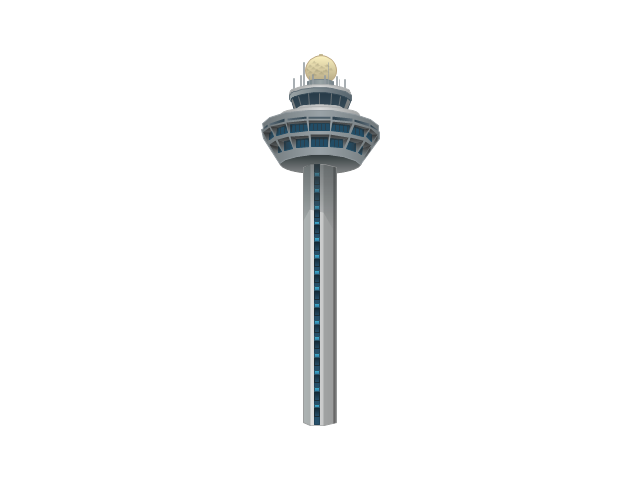
- AIRPORT TOWER CODE
- AIRPORT TOWER FREE
The configuration of each Class B airspace area is individually tailored and consists of a surface area and two or more layers (some Class B airspace areas resemble upside‐down wedding cakes), and is designed to contain all published instrument procedures once an aircraft enters the airspace. Generally, that airspace from the surface to 10,000 feet MSL surrounding the nation's busiest airports in terms of IFR operations or passenger enplanements. Class A airspace is not specifically charted.

Unless otherwise authorized, all persons must operate their aircraft under IFR.
Operating Rules and Pilot/Equipment Requirements. Generally, that airspace from 18,000 feet MSL up to and including FL 600, including the airspace overlying the waters within 12 nautical miles off the coast of the 48 contiguous States and Alaska and designated international airspace beyond 12 nautical miles off the coast of the 48 contiguous States and Alaska within areas of domestic radio navigational signal or ATC radar coverage, and within which domestic procedures are applied. No person may make a parachute jump, and no pilot-in-command may allow a parachute jump to be made from that aircraft, in or into Class A, Class B, Class C, or Class D airspace without, or in violation of, the terms of an ATC authorization issued by the ATC facility having jurisdiction over the airspace. AIRPORT TOWER FREE
Unless otherwise authorized by ATC, no person may operate an unmanned free balloon below 2,000 feet above the surface within the lateral boundaries of Class B, Class C, Class D, or Class E airspace designated for an airport. No person may operate an ultralight vehicle within Class A, Class B, Class C, or Class D airspace or within the lateral boundaries of the surface area of Class E airspace designated for an airport unless that person has prior authorization from the ATC facility having jurisdiction over that airspace. When feasible, the controller will offer the pilot an alternative course of action. An Aircraft Conflict/Mode C Intruder Alert is issued if the controller observes another aircraft which places it in an unsafe proximity.
Aircraft Conflict/Mode C Intruder Alert. A Terrain/Obstruction Alert is issued when, in the controller's judgment, an aircraft's altitude places it in unsafe proximity to terrain and/or obstructions and Safety Alerts are mandatory services and are provided to ALL aircraft. Traffic advisories will be provided to all aircraft as the controller's work situation permits. The pilot retains this responsibility when receiving ATC radar advisories. It is the responsibility of the pilot to ensure that ATC clearance or radio communication requirements are met prior to entry into Class B, Class C, or Class D airspace. Standard IFR separation is provided to all aircraft operating under IFR in controlled airspace. IFR operations in any class of controlled airspace requires that a pilot must file an IFR flight plan and receive an appropriate ATC clearance. A generic term that covers the different classification of airspace (Class A, Class B, Class C, Class D, and Class E airspace) and defined dimensions within which air traffic control service is provided to IFR flights and to VFR flights in accordance with the airspace classification. FAA Form 7233−4 International Flight Plan UAS Pilot Testing, Certification and Responsibilities. Aeronautical Charts and Related Publications. Bird Hazards and Flight Over National Refuges, Parks, and Forests. Cold Temperature Barometric Altimeter Errors, Setting Procedures and Cold Temperature Airports (CTA). 
Barometric Altimeter Errors and Setting Procedures.Aircraft Rescue and Fire Fighting Communications.National Security and Interception Procedures.Pilot/Controller Roles and Responsibilities.Operational Policy/Procedures for the Gulf of Mexico 50 NM Lateral Separation Initiative.Operational Policy/Procedures for Reduced Vertical Separation Minimum (RVSM) in the Domestic U.S., Alaska, Offshore Airspace and the San Juan FIR.
 Radio Communications Phraseology and Techniques. Air Navigation and Obstruction Lighting. Aeronautical Lighting and Other Airport Visual Aids. Performance-Based Navigation (PBN) and Area Navigation (RNAV).
Radio Communications Phraseology and Techniques. Air Navigation and Obstruction Lighting. Aeronautical Lighting and Other Airport Visual Aids. Performance-Based Navigation (PBN) and Area Navigation (RNAV). AIRPORT TOWER CODE
Code of Federal Regulations and Advisory Circulars.







 0 kommentar(er)
0 kommentar(er)
